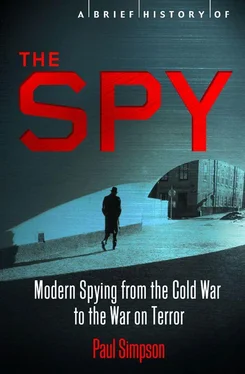Paul Simpson - A Brief History of the Spy
Здесь есть возможность читать онлайн «Paul Simpson - A Brief History of the Spy» весь текст электронной книги совершенно бесплатно (целиком полную версию без сокращений). В некоторых случаях можно слушать аудио, скачать через торрент в формате fb2 и присутствует краткое содержание. Город: London, Год выпуска: 2013, ISBN: 2013, Издательство: Constable & Robinson, Жанр: Прочая документальная литература, на английском языке. Описание произведения, (предисловие) а так же отзывы посетителей доступны на портале библиотеки ЛибКат.
- Название:A Brief History of the Spy
- Автор:
- Издательство:Constable & Robinson
- Жанр:
- Год:2013
- Город:London
- ISBN:9781780338910
- Рейтинг книги:3 / 5. Голосов: 1
-
Избранное:Добавить в избранное
- Отзывы:
-
Ваша оценка:
- 60
- 1
- 2
- 3
- 4
- 5
A Brief History of the Spy: краткое содержание, описание и аннотация
Предлагаем к чтению аннотацию, описание, краткое содержание или предисловие (зависит от того, что написал сам автор книги «A Brief History of the Spy»). Если вы не нашли необходимую информацию о книге — напишите в комментариях, мы постараемся отыскать её.
A Brief History of the Spy — читать онлайн бесплатно полную книгу (весь текст) целиком
Ниже представлен текст книги, разбитый по страницам. Система сохранения места последней прочитанной страницы, позволяет с удобством читать онлайн бесплатно книгу «A Brief History of the Spy», без необходимости каждый раз заново искать на чём Вы остановились. Поставьте закладку, и сможете в любой момент перейти на страницу, на которой закончили чтение.
Интервал:
Закладка:
The CIA’s successful involvement in the Italian election of 1948 was just the start of their intervention in the affairs of other countries. Sometimes this was by invitation of some of the parties involved — such as in China, where the nationalist government of Chiang Kai-shek welcomed the CIA assistance — but by no means was this always the case.
Operation Ajax was a case in point. The CIA’s actions in Iran helped keep the Shah in power until the coup of 1979, but as its instigator, Kermit Roosevelt, would later note: ‘If we, the CIA, are ever going to try something like this again, we must be absolutely sure that the people and the army want what we want. If not, you had better call in the marines.’ The problem was: the CIA was acting against what a democratically elected government had decided.
The problem arose when the concession that granted oil rights in Iran to the British-run Anglo-Iranian Oil Company (AIOC) came up for review in 1950. The Iranian parliament, the Majlis, called for the terms to be renegotiated so they weren’t so favourable to the AIOC. One member of the Majlis, Mohammed Mossadegh, a Europe-educated lawyer in his early seventies, became the focal point for the opposition, and in March 1951, the AIOC’s holdings were nationalized. Mossadegh was then elected prime minister on 29 April. The British didn’t take kindly to this: describing it as ‘a series of insensate actions’, they claimed that ‘Unless this is promptly checked, the whole of the free world will be much poorer and weaker, including the deluded Iranian people themselves.’ The Iranian people themselves, however, considered Mossadegh to be a hero for standing up to the British.
Although the Americans wouldn’t initially assist the British with removing Mossadegh, the Iranian’s unwillingness to deal with the increasing influence of the Communist party meant that he came into focus for the CIA as a potential enemy, and so Project Ajax was born. In March 1953, an Iranian army general approached the Americans about backing an Army-led coup, and there was concern that the Communists would step in during the chaos. DCI Allen Dulles approved the operation to ‘bring about the fall of Mossadegh’ on 4 April. General Zahedi was seen as the ideal figurehead for the new regime, and CIA and MI6 agents discussed how best to run the operation (with the CIA not trusting the British with details of their own assets inside the country).
The operation came close to collapse because of the weakness of the Shah of Iran, whose role was to dismiss Mossadegh and appoint Zahedi. After much vacillating, he eventually did so on 13 August, but the coup was very nearly a disaster. On more than one occasion, Roosevelt was advised to leave Tehran, the operation a failure, but, more by luck than judgement, it was eventually successful.
The CIA’s own official history of the project — leaked to the New York Times — describes the final day of the coup as ‘a day that should never have ended for it carried with it such a sense of excitement, of satisfaction and of jubilation that it is doubtful whether any other can come up to it’. It would lead to a similarly aimed operation in Guatemala the following year; it can also be seen as a forerunner of the disastrous CIA operation which came apart at the Bay of Pigs in Cuba in 1961.
According to the CIA’s own in-house historians, their operation in Guatemala, confidently code-named Success, was ‘an intensive paramilitary and psychological campaign to replace a popular elected government with political nonentity. In method, scale, and conception it had no antecedent and its triumph confirmed the belief of many in the Eisenhower administration that covert operations offered a safe, inexpensive substitute for armed force in resisting Communist inroads in the Third World.’ Assassination plots, paramilitary and economic warfare, provocation techniques, psychological operations, rumour campaigns and sabotage all played their part in toppling Jacobo Árbenz Guzmán, the second legally elected president in Guatemalan history and replacing him with Colonel Carlos Castillo Armas.
Árbenz was tolerant of locally known Communists, making him what the Americans regarded as a ‘fellow traveller’ and possibly a Communist himself, and when he brought in an Agrarian Reform Law that redistributed land belonging to the United Fruit Company this made some in the US administration believe that the Communists had now established a beachhead in Latin America via Árbenz.
The CIA felt that the military were ‘the only organized element in Guatemala capable of rapidly and decisively altering the political situation’, but the agency was aware that they would need considerable encouragement to make the right decision. Graffiti, political pamphlets, character assassinations and the daily delivery of fake death-notices to Árbenz and members of his cabinet all helped to prepare the way for the eventual invasion.
In the end, the army did turn on Árbenz, and he was forced to resign — but their actions perhaps were dictated more by the concern that the Americans would invade if Guzman remained in power, than because they feared the frankly feeble Colonel Armas and his very small Ejército de liberación. Dulles presented the results of Operation Success to President Eisenhower as a virtually bloodless coup, although he was aware that more than four dozen people had actually been killed.
After losing so many key agents in the West thanks to the various defections and revelations from the Venona transcripts, the KGB needed to rebuild its networks. In addition to infiltrating George Blake into MI6, they also targeted French intelligence and the new West German organization. Many of these were never discovered, unlike one of their best agents (in his own opinion) Georges Pâques, who was Chef de Cabinet and adviser to several French ministers in the post-war period before becoming a key agent during de Gaulle’s administration in 1958.
Former SS captain Hans Clemens, already working for Moscow, was recruited by the West German intelligence agency and in 1951 was able to turn another former SS officer Heinze Felfe, who distinguished himself in Western eyes by allegedly setting up a network of agents in Moscow — all of whose ‘information’ was carefully prepared by Moscow Centre, in the full knowledge it would reach West German Chancellor Konrad Adenauer.
In Norway in 1949, the KGB was able to recruit Gunvor Galtung Haavik, an employee at the Norwegian embassy in Moscow, by threatening to send her Russian lover to Siberia. Sent back to Oslo in 1955, she became an important source for the KGB at her new posting at the Norwegian Ministry of Foreign Affairs for the next twenty-two years, until her cover was blown by British agent Oleg Gordievsky in 1977.
However, as many, if not more, of State Security’s operations would be directed internally. Stalin believed that the break between Russia and Yugoslavia was simply part of a wide-ranging imperialist conspiracy to undermine the Soviet power bloc, and agents were on the hunt for conspirators. The Hungarian Minister of the Interior, László Rajk was accused of being part of a grand Titoist conspiracy against the Soviets and was subject to a show trial in Budapest in 1949. An anti-Semitic witch-hunt began after Stalin perceived links between the new state of Israel and the USA, and switched Soviet support to Israel’s Arab enemies. This was to form the last great purge of Stalin’s life, with all Jewish officers (bar a number of so-called ‘hidden Jews’ who were officially part of other ethnic groups) removed from positions of power, and from the MGB. A perceived plot against the state by doctors saw the dictator’s rage vented on those who ‘trampled the sacred banner of science’ — agents of British and American intelligence working through ‘a corrupt Jewish bourgeois nationalist organisation’.
Читать дальшеИнтервал:
Закладка:
Похожие книги на «A Brief History of the Spy»
Представляем Вашему вниманию похожие книги на «A Brief History of the Spy» списком для выбора. Мы отобрали схожую по названию и смыслу литературу в надежде предоставить читателям больше вариантов отыскать новые, интересные, ещё непрочитанные произведения.
Обсуждение, отзывы о книге «A Brief History of the Spy» и просто собственные мнения читателей. Оставьте ваши комментарии, напишите, что Вы думаете о произведении, его смысле или главных героях. Укажите что конкретно понравилось, а что нет, и почему Вы так считаете.












